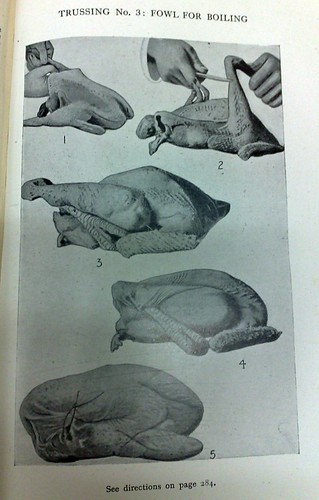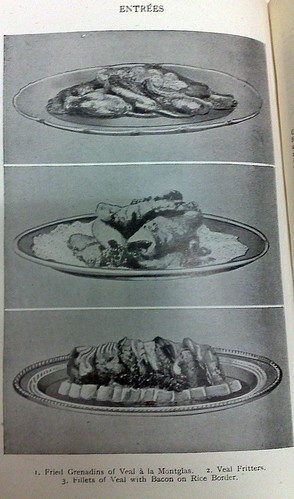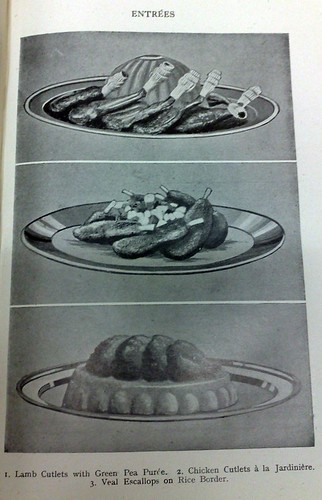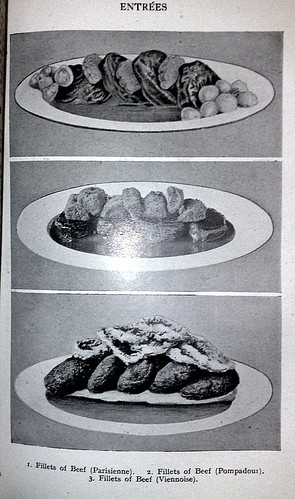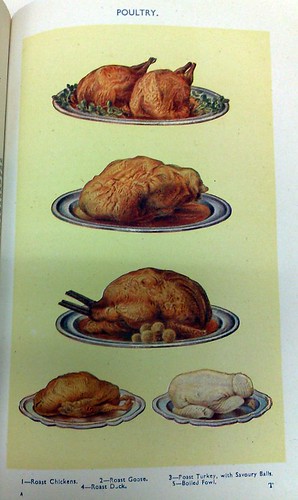
Friday, October 23, 2009
Fly away on my Zephyr
zephyr (plural zephyrs)
1. a light wind from the west
2. any light refreshing wind; a gentle breeze
3. any thing of fine, soft, or light quality, especially fabric
Strangely, I cannot find zéphire(s) in the dictionary so I'm just going with zephyr, and considering cheese zéphires are made with whipped cream it probably fits. I thought they were a touch boring on their own but served on garlic toasts with a bit of tomato, quite yum.
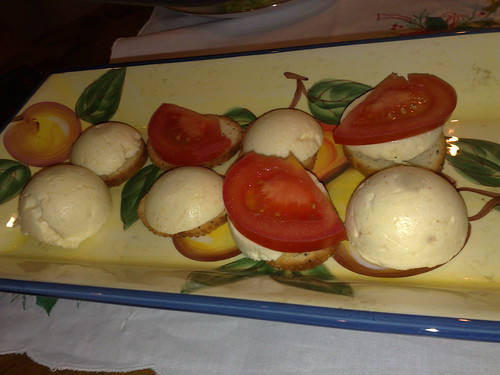
CHEESE ZÉPHIRES.
INGREDIENTS. - 3 heaped tablespoonfuls of Parmesan cheese
1 oz. of gelatine
1/2 a pint of cream
1/2 a pint of milk
cayenne
salt
METHOD. - Soak the gelatine in the milk for about 1/2 an hour, then stir it over the fire until it is dissolved.
Let it cool, add the cheese, the cream previously stiffly whipped, and seasoning to taste.
Turn into oval fluted zéphire moulds, set on ice until firm, then unmould, and serve garnished with chopped aspic jelly and shredded truffle and pimiento.
TIME. - About 4 hours. SUFFICIENT for 6 or 7 persons.
And I'm not sure what a zéphire mould is either, I just used a round cupcake pan to get some cute little domes.
1. a light wind from the west
2. any light refreshing wind; a gentle breeze
3. any thing of fine, soft, or light quality, especially fabric
Strangely, I cannot find zéphire(s) in the dictionary so I'm just going with zephyr, and considering cheese zéphires are made with whipped cream it probably fits. I thought they were a touch boring on their own but served on garlic toasts with a bit of tomato, quite yum.

CHEESE ZÉPHIRES.
INGREDIENTS. - 3 heaped tablespoonfuls of Parmesan cheese
1 oz. of gelatine
1/2 a pint of cream
1/2 a pint of milk
cayenne
salt
METHOD. - Soak the gelatine in the milk for about 1/2 an hour, then stir it over the fire until it is dissolved.
Let it cool, add the cheese, the cream previously stiffly whipped, and seasoning to taste.
Turn into oval fluted zéphire moulds, set on ice until firm, then unmould, and serve garnished with chopped aspic jelly and shredded truffle and pimiento.
TIME. - About 4 hours. SUFFICIENT for 6 or 7 persons.
And I'm not sure what a zéphire mould is either, I just used a round cupcake pan to get some cute little domes.
Tuesday, October 20, 2009
The devil is in the detail
Angels on Horseback and Devils on Horseback - which is which? You guess. Angels on Horseback are actually a 'savoury' in Mrs Beeton which would therefore come at the end of the meal. But seeing as we are not really in the habit of eating more after the sweets, I decided to make them as an Hors d'œuvre instead.
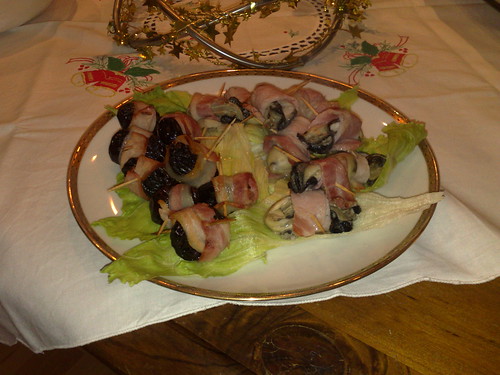
"ANGELS ON HORSEBACK"
INGREDIENTS. - 12 oysters
12 small thin slices of bacon
12 small round croûtes of bread
1/2 a teaspoon of finely-chopped shallot
1/2 a teaspoon of finely-chopped parsley
a little lemon juice
Krona pepper
METHOD. - Beard the oysters, trim the bacon, cutting each piece just large enough to roll round an oyster, season with Krona pepper, sprinkle on a little shallot and parsley.
Lay an oyster on each, add a few drops of lemon-juice, roll up tightly, and secure the bacon in position with a large pin.
Fry in a frying-pan or bake in a hot oven just long enough to crisp the bacon (further cooking would harden the oyster), remove the pins and serve on the croûtes.
TIME. - About 20 minutes. SUFFICIENT for 8 or 9 persons.
If you are planning on serving these at a party, baking needs less attention allowing you to enjoy more time with your guests. I left my pins (or toothpick in this case) in for ease of serving and eating when hors d'œuvring.
"DEVILS ON HORSEBACK."
INGREDIENTS. - 12 prunes
12 small thin slices of bacon
12 small round croûtes of bread
1/2 a teaspoon of finely-chopped shallot
1/2 a teaspoon of finely-chopped parsley
Krona pepper
METHOD. - Trim the bacon, cutting each piece just large enough to roll round an oyster, season with Krona pepper, sprinkle on a little shallot and parsley.
Lay a prune on each, roll up tightly, and secure the bacon in position with a large pin.
Fry in a frying-pan or bake in a hot oven just long enough to crisp the bacon and warm the prune, remove the pins and serve on the croûtes.
TIME. - About 20 minutes. SUFFICIENT for 8 or 9 persons.
These are also pretty tasty, but remember they still have a pip in them (being dried plums) so have a little bowl or something to receive the pips.

"ANGELS ON HORSEBACK"
INGREDIENTS. - 12 oysters
12 small thin slices of bacon
12 small round croûtes of bread
1/2 a teaspoon of finely-chopped shallot
1/2 a teaspoon of finely-chopped parsley
a little lemon juice
Krona pepper
METHOD. - Beard the oysters, trim the bacon, cutting each piece just large enough to roll round an oyster, season with Krona pepper, sprinkle on a little shallot and parsley.
Lay an oyster on each, add a few drops of lemon-juice, roll up tightly, and secure the bacon in position with a large pin.
Fry in a frying-pan or bake in a hot oven just long enough to crisp the bacon (further cooking would harden the oyster), remove the pins and serve on the croûtes.
TIME. - About 20 minutes. SUFFICIENT for 8 or 9 persons.
If you are planning on serving these at a party, baking needs less attention allowing you to enjoy more time with your guests. I left my pins (or toothpick in this case) in for ease of serving and eating when hors d'œuvring.
"DEVILS ON HORSEBACK."
INGREDIENTS. - 12 prunes
12 small thin slices of bacon
12 small round croûtes of bread
1/2 a teaspoon of finely-chopped shallot
1/2 a teaspoon of finely-chopped parsley
Krona pepper
METHOD. - Trim the bacon, cutting each piece just large enough to roll round an oyster, season with Krona pepper, sprinkle on a little shallot and parsley.
Lay a prune on each, roll up tightly, and secure the bacon in position with a large pin.
Fry in a frying-pan or bake in a hot oven just long enough to crisp the bacon and warm the prune, remove the pins and serve on the croûtes.
TIME. - About 20 minutes. SUFFICIENT for 8 or 9 persons.
These are also pretty tasty, but remember they still have a pip in them (being dried plums) so have a little bowl or something to receive the pips.
Monday, October 19, 2009
The secret to staying young is to live honestly, eat slowly, and lie about your age.
Well, I had a birthday recently. And for said birthday I had a dinner party of almost Herculean standards. Well for me anyway. It was a "How to host a Murder" Party set at a movie premiere in 1936.
So naturally I go way overboard with the cooking but it was all in good fun.
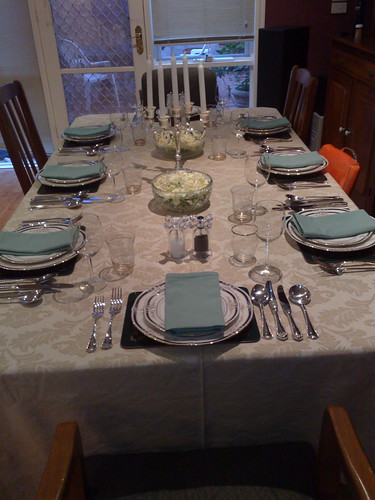
Here is my table all beautifully set. I polished the silver myself as it's so hard to get good staff these days. I even measured my table to ensure everyone had the required 24". It required 1 extra leaf in my table, just to seat 8. And an appropriate use flowers to follow the colour scheme. I think it's pretty if I do say so myself.
So to a brief overview of the menu then.
Hors d'œuvres
Oysters au Naturel
Cheese Zephires
Angels on Horseback
Devils on Horseback
Soup
Clear Julienne Soup
Entrées
Chicken Cannelons
Salmon Mousse
Rabbit Rillet
Main
Roast Beef
Roast Potatoes confit in Duck fat
Asparagus
Carrots
Peas
Gravy
Sweets
Raspberry Cream
Cake
Ingrid's Chocolate cake
And now on to some recipes:
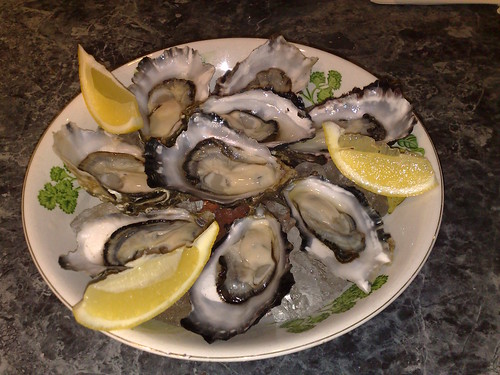
OYSTERS AU NATUREL.
There are many ways of dressing oysters, either hot or cold, but only one way of serving them, "au naturel," which is considered the most popular hor's dœurve. Only the best kinds, natives - Whitstable or Colchester oysters, should be served "au naturel," i.e., raw. All the need, after being opened, is to be placed on the upper shell with a little of the liquor; they are then ranged on a dish, garnished with sprigs of fresh parsley, and if possible, surrounded with shaved ice.
Some thin slices of buttered brown bread, and quarters of lemon are handed round at the same time; also Nepaul or cayenne pepper.
I have to confess I didn't check to see if my oysters were Whitstable or Colchester but they were yummy none the less. I substitued those garlic toast biscuits instead of the buttered brown bread.
So naturally I go way overboard with the cooking but it was all in good fun.

Here is my table all beautifully set. I polished the silver myself as it's so hard to get good staff these days. I even measured my table to ensure everyone had the required 24". It required 1 extra leaf in my table, just to seat 8. And an appropriate use flowers to follow the colour scheme. I think it's pretty if I do say so myself.
So to a brief overview of the menu then.
Hors d'œuvres
Oysters au Naturel
Cheese Zephires
Angels on Horseback
Devils on Horseback
Soup
Clear Julienne Soup
Entrées
Chicken Cannelons
Salmon Mousse
Rabbit Rillet
Main
Roast Beef
Roast Potatoes confit in Duck fat
Asparagus
Carrots
Peas
Gravy
Sweets
Raspberry Cream
Cake
Ingrid's Chocolate cake
And now on to some recipes:

OYSTERS AU NATUREL.
There are many ways of dressing oysters, either hot or cold, but only one way of serving them, "au naturel," which is considered the most popular hor's dœurve. Only the best kinds, natives - Whitstable or Colchester oysters, should be served "au naturel," i.e., raw. All the need, after being opened, is to be placed on the upper shell with a little of the liquor; they are then ranged on a dish, garnished with sprigs of fresh parsley, and if possible, surrounded with shaved ice.
Some thin slices of buttered brown bread, and quarters of lemon are handed round at the same time; also Nepaul or cayenne pepper.
I have to confess I didn't check to see if my oysters were Whitstable or Colchester but they were yummy none the less. I substitued those garlic toast biscuits instead of the buttered brown bread.
Sunday, October 18, 2009
How much of human life is lost in waiting.

HOW TO WAIT AT TABLE
ORDER AND ROUTINE.
The waiting commences from the head of the table, and there must be assistants, outside the door, to bring the dishes and remove them entirely from the room. When the dinner is served on the table the attendant must stand at the left-hand side of the carver, and remove the covers. As the soup comes first, a plateful is carried to each person, unless they signify they do not wish for any, and commences from the one on the right of the host. The sherry or claret is then handed round. At a large gathering the moment a person's plate is empty, or finished with, it must be quietly taken away, spoon and all, but when the party is only a small one, the plates are usually left until all have finished the course. In any case, the plates of the host and hostess are always left till last. At informal parties guests should be asked if they wish for a second helping, but not at formal gatherings. Never remove a dish which is being served until all have finished that course. The fish is carried round in the same manner as the soup, the attendant having in the left hand the sauce-boat, or being followed by another servant carrying it. All plates are placed by the attendant at the left-hand side of the person being served, and when used removed from the left or right. Entrées are invariably handed even when the joints are carved upon the table. When the joint comes on, and the meat has been taken to the guests as before, the vegetables (which are usually placed upon the sideboard, and not on the table) are handed about, together with a sauce-boat of gravy for fowls or birds. As soon as all have been served with the meat course the wines are again handed round. The meat course finished, the soiled plates are removed, and the sweet course, followed by the savoury, is brought in. Dinner over, the unused cutlery, the glass, cruets and carving cloth are brushed away from the guests' left-hand side; the dessert-plates, finger bowls and port glasses are arranged upon the table; and after everything is in proper order, the port and a few dishes are handed round by the attendants. who then leave the room. In handing aerated waters, lemonade, etc., the attendant takes the small tray or salver in the left hand and, standing on the left side of the guest who places his or her glass upon it, pours out the required liquid with the right hand. When clean knives and forks are required, they must be placed on the table and not handed on the salver.
At hospitality school we learnt to serve from the right and clear from the left... I wonder which is the more "correct" way or if it has changed over the years?
Dishes should be handed at a convenient level: they are usually served too high and not far enough forward. They should be served with the left hand, the body turned a little to the right. If the right hand be free do not rest it on the back of the chair.
Heaven forbid your wait staff should get overly familiar with your guests and dare to touch their chair.
Saturday, October 17, 2009
Hope is a good breakfast, but it is a bad supper.

FAMILY SUPPERS.
At these, food of a light description should be served, and to make these meals enjoyable the dishes should be as varied as possible. Fish re-dressed in the form of mayonnaises, croquettes, or pies, can easily be made into a good supper dish; the remains of poultry or game hashed make a tempting and savoury one where hot dishes are liked, and all kinds of odds and ends can, with a little ingenuity, be utilized to form more appetising food at supper time than perpetual cold meat. Salad or cucumber should not be wanting at the family meal in summer, when such things are plentiful and cheap, while in winter a few cold potatoes friend make a nice addition, or a well-made potato salad. As with breakfast dishes, those for supper are more a question of trouble and time than cost.
Friday, October 16, 2009
You can't fake quality any more than you can fake a good meal.
 TO LAY THE CLOTH FOR DINNER.
TO LAY THE CLOTH FOR DINNER.The cloth itself must first be put on straight and evenly, and if at all creased should be pressed with a clean iron over a damp cloth. The cloth should not be laid upon the bare table, but the table should be first covered by some asbestos-felt or an old cloth. Should the housewife wish to display her highly-polished table, she may dispense with a table-cloth and use dainty lace mats for each plate or dish, taking care to protect the polish of the table by using small asbestos mats under the fancy mats.
Here we go with the asbestos again. I believe all of my place mats are cork backed, so I hope that suffices.
Everything necessary for laying the cloth, including the napkins, should first be brought into the room, and it is a good plan to put the latter round the table first, so that the same amount of space can be allowed to each person.
Remember we're giving each person AT LEAST 24 inches. Except at a lot of restaurants where they really don't seem to care if you keep nudging the person next to you when cutting your steak.
These occupy the space between the knives and forks, and in each, if folded, should be put either a dinner roll or a piece of bread cut rather thick.
Remembering of course that side plates are a definite no-no at dinner.
Table-napkins are often merely folded over and laid flat on the plate ready for the hors d'œuvre, between the knives and forks; a small knife is then laid on the napkin.
Next place the menu cards, if these are used, either one to each person, or one between three or four, if only a few are provided.
The water jugs, cruets and salt cellars may next be laid. There should be a cruet at each corner of the table, while a salt cellar should be between every two persons. We now come to the knives and forks, and of these it is usual to lay a large one of each, the knife flanked to the right by a fish knife, a soup spoon, and an hors d'œuvre fork, and on the left of the fork should be the fish fork; other knives and forks are supplied with the plates for different courses.
A cruet set is a collection of little bottles of vinegar and oil and pepper... sometimes salt as well.
The question of what wine is to be drunk at dinner will determine what glasses are wanted, as the glasses used for dessert are put on afterwards.
Supposing, as is so often the case, sherry, champagne and claret are to be served, put the proper glasses for each to the right side of each person, setting them in a triangle, with the sherry glass (the first used) at the top, just reaching to the point of the knife, but at a convenient distance from it.
Exactly the same way we were taught to put glasses on the table at hospitality school. Some things never change.
The sideboard requires to be laid as carefully as the dinner-table itself, and everything that can be put there ready for placing on the table afterwards, such as finger-bowls, glasses for dessert wine, dessert plates, decanters, and knives, forks and spoons of every kind should be there ready and carefully arranged. The decanters, salvers, glasses, etc., should be put well at the back of the sideboard, and the plates, knives, forks, etc., neatly laid in front.
When the dinner is not carved on the table, one specially intended for the carver should be prepared with carving knives and forks (the former carefully sharpened beforehand) of various kinds, soup ladle, fish-carvers, etc., in the order of serving the dinner, that nothing may delay him when he commences his duties.
I always, always, always carve in the kitchen. I don't know why, but it seems easier somehow, and I always make a big mess which would probably ruin my table cloth.
Champagne, hock, or other sparkling wines that are only uncorked when wanted, may find a place under the sideboard of side tables where the ice pails are to be found; decanted wines are put on the sideboard.
Tuesday, October 13, 2009
After a good dinner one can forgive anybody, even one's own relations.
 DINNER.
DINNER.When dinner is placed upon the table, if there is only on chief dish place it at the head of the table. If two, one to the host and one to the hostess. If three, one (the principle) at the head and the other two together near the bottom. If four, the two principle at top and bottom, the others at the sides. Six dishes can be arranged as for four. Seven will require three dishes down the middle of the tale and two on either side.
To be honest, I think I just plonk 'em down wherever they will fit. My bad...
Courses. - The order of the courses of a modern dinner should be as follows: the soup is usually preceded by an Hors 'dœvre, such as caviare, croûtons, sardines, oysters, or other little appétissants.
The First Course is usually soup, the second fish, then comes the entrées (made dishes). The next Course, joints, then poultry and game, and after these sweets, then savory dishes, then cheese and celery. When there are two roast meats they should be opposite colours, i.e., not two whites or two browns. Entrées require care in handling; there is nearly always gravy with them, and this must not be upset upon the cloth. The last arrangement of dishes - which cannot be called a course, seeing that the dinner is virtually over - the dessert comprises tastefull arranged fruits that are most in season.
Following is a specimen menu:-
SPECIMEN MENU FOR A DINNER
FRENCH
Potage.
Consommé a la Colbert
Poisson.
Turbot bouilli
Sauce aux Huîtres.
Entrée.
Filet de Bœuf à la Brillat
Tomate farcies à l'Italienne
Rôti.
Faisan bardé au Cresson.
Salase de Saison. Pommes frites.
Entremets.
Omelette à la Célestine.
Gelée aux Bananes.
Bonne Bouche.
Buissone d'Ecrevisse.
Dessert.
ENGLISH
Soup.
Clear Soup with Poached Eggs.
Fish.
Boiled Turbot. Oyster Sauce
Entrée.
Braised Fillet of Beef.
Stuffed Tomates.
Roast.
Roast Pheasant with Cress.
Chipped Potatoes. Salad.
Sweets.
Omelet with Preserved Fruit.
Banana Jelly.
Savoury.
Dressed Prawns.
Dessert.
I always just assumed sweets and dessert were meant to be the same thing and people were just being pretentious. However, it is evident in this context that they are completely different things. It also makes my 6 course meal into only 4 courses, because Hors d'œurves don't count as a course... and I would imagine neither does cake.
In giving a dinner it is far better to have a simple meal, which one knows will be properly cooked and serves, than to risk anything elaborate, for it is difficult to appear utterly unconcerned when one is harassed by petty cares, and a thoroughly good hostess is one who is able herself to enjoy, without anxiety, the dinner she is giving.
This is by far and away the most important point I think in the whole chapter. Emily Post also agrees that it is better to have a good simple meal than a bad elaborate one. Also on this note, it is hard to enjoy oneself with a giant burn on ones' hand as happened at a recent dinner of mine and put a pretty big dampner on the whole evening.
The temperature of the room is a very important subject that is often overlooked. It is not possible thoroughly to enjoy a good dinner in a room either too hot or too cold.
Particularly a hot cooked Christmas dinner on a 44oC day in Australia.
Monday, October 12, 2009
Tuesday, October 6, 2009
I'm flattered
Well, I'm honoured to receive the Kreativ Blogger award.

The "RULES" of this award are that I am to:
1) tell you seven things that you don't already know about me.
2) I am to name seven other blogs to receive this award.
3)I am to leave a comment on each of the blogs I have nominated letting them know that I have given them an award.
4) And lastly, I am to thank the blog that you gave me the award.
seven things you may not know about me...
1) I have a small piece of gravel in my forehead. Long story short, don't do hurdles on the gravel yard.
2) I love sewing, but HATE HATE HATE cutting out so I have a large pile of material and patterns all waiting for the scissors faries to do their magic
3) I'd love to flounce around in my house in a BIG crinoline, but I don't think I'd fit down the hallways.
4) I have an unnatural interest in English history. No seriously... apparently it's not the current fad at Australian Universities
5) I have Dutch heritage which I like to exploit by wearing clogs and plaits and riding a bicycle... also eating olle bollen, croquettes and other fried foods
6) I was scared away from the local SCA group because when I went past their stall at 'O' week at uni there was a very large lady with a distrubingly large amount of bosom on show
7) I am always surprised that there are people interested in reading my blog
There are a heap of great blogs that I love but here are just a few that I nominate for this award:
1) Jitterbug at Destination 1940
2) Trixie at That's just stupid what you said
3) Vintage Verve at Vintage Verve
4) LaPetiteMort at LaPetiteMort
5) Roxanne at The Haven of Home
6) Packrat at Swatting at flies
7) Lolita Haze at Vintage Starlet
Many thanks to Wearing History for the nomination

The "RULES" of this award are that I am to:
1) tell you seven things that you don't already know about me.
2) I am to name seven other blogs to receive this award.
3)I am to leave a comment on each of the blogs I have nominated letting them know that I have given them an award.
4) And lastly, I am to thank the blog that you gave me the award.
seven things you may not know about me...
1) I have a small piece of gravel in my forehead. Long story short, don't do hurdles on the gravel yard.
2) I love sewing, but HATE HATE HATE cutting out so I have a large pile of material and patterns all waiting for the scissors faries to do their magic
3) I'd love to flounce around in my house in a BIG crinoline, but I don't think I'd fit down the hallways.
4) I have an unnatural interest in English history. No seriously... apparently it's not the current fad at Australian Universities
5) I have Dutch heritage which I like to exploit by wearing clogs and plaits and riding a bicycle... also eating olle bollen, croquettes and other fried foods
6) I was scared away from the local SCA group because when I went past their stall at 'O' week at uni there was a very large lady with a distrubingly large amount of bosom on show
7) I am always surprised that there are people interested in reading my blog
There are a heap of great blogs that I love but here are just a few that I nominate for this award:
1) Jitterbug at Destination 1940
2) Trixie at That's just stupid what you said
3) Vintage Verve at Vintage Verve
4) LaPetiteMort at LaPetiteMort
5) Roxanne at The Haven of Home
6) Packrat at Swatting at flies
7) Lolita Haze at Vintage Starlet
Many thanks to Wearing History for the nomination
Game on, Elizabeth David...

I recently had a birthday, and for said birthday a lovely family friend gave me a cookery book (everyone seems to have picked up on my exciting new-ish obsession for cookery books...).
I got Elizabeth David's French Provincial Cooking, first published in 1960.
Elizabeth David is considered responsible for bringing French and Italian cooking into the British home (along with now ubiquitous items such as olive oil and the courgette). In a Britain worn down by post-war rationing and dull food, she celebrated the regional and rural dishes of the Mediterranean rather than the fussier food of the gourmands and aristocrats. David's style is characterised by terse descriptions of the recipes themselves, accompanied by detailed descriptions of their context and historical background, and often laced with anecdotal asides. She was often scathing of bad food, including much of the food of England that she and her readers had grown up with.
I used her book in conjunction with Mrs Beeton for one dish of my latest and greatest dinner party, so I was most distressed to read this quote from her.
"If I had been given a standard Mrs Beeton instead of Mrs Leyel's wonderful recipes," she said, "I would probably never have learned to cook."
I find it endlessly interesting that a woman who was born in 1913 and was given her first cook book age 19 (The Gentle Art of Cookery by Hilda Leyel) saw Mrs Beeton as the epitome of boring and bland British Cookery, whereas I, born 70 years later, find Mrs Beeton inhabiting a fascinating world of interesting ingredients and ideas. Things that were common place for Mrs Beeton and for Ms David are strange and unusual for me. And no doubt things that are ordinary for me would be bewildering for Mrs Beeton or anyone else of that era.
Anyway, I'll not hold Ms David's poor opinion of Mrs Beeton against her, as really... she didn't know any better.
Subscribe to:
Comments (Atom)

